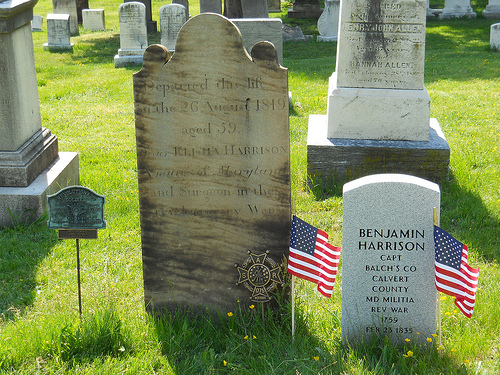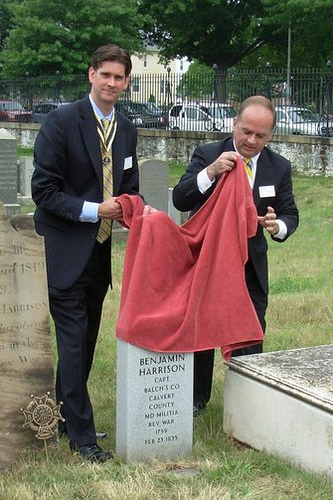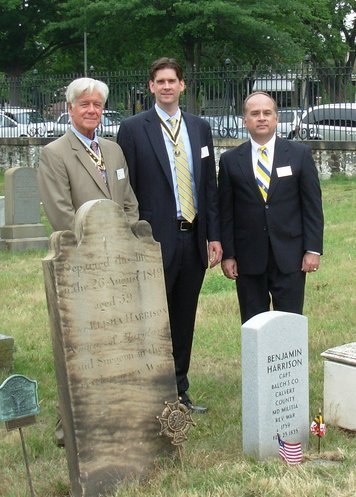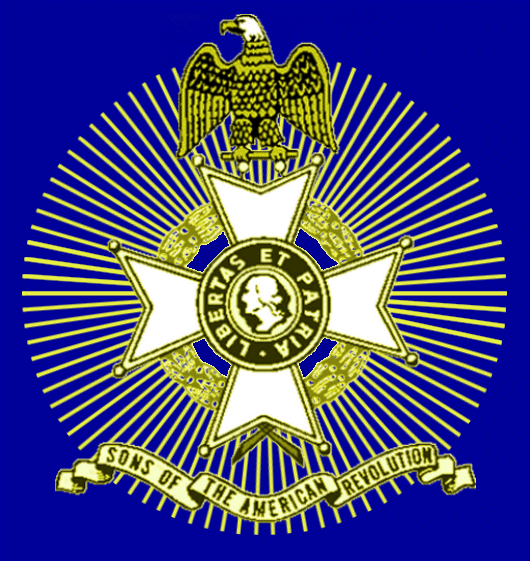The Revolutionary Services of Benjamin Harrison
By John D. Sinks
District of Columbia Society, Sons of the American Revolution
July 4, 2011
Benjamin Harrison was born in Calvert County, Maryland in the year 1759. Calvert County lies between the Patuxent River and the Chesapeake Bay. This made the county vulnerable to incursions from British ships during the Revolution. Although there were no prime military targets in many coastal counties, ships would send parties ashore to forage for food and fresh water, carry off slaves, plunder, and sometimes burn the property of a prominent patriot or a town of insolent rebels. As a consequence, the militia in coastal counties had active duty of a different nature from most. Most militia would drill periodically and a few might guard the jail if Tories or prisoners of war were held there. Part of a county militia would be called out, usually for two to three month periods, with the need being met by a combination of volunteers and draftees. They would march from to join a campaign or to guard duty at a strategic location. By contrast, in coastal counties militia had to be on constant watch. When an incursion occurred reinforcements were required to respond on a moment’s notice. Whereas many pensioners who served in the militia would often testify they served two or three tours of duty, usually about 3 months each but sometimes as short as two and as long as six months, coastal militia men would testify that they served continuously on active duty watching for the enemy and responding to incursions numerous times. One coastal militia man, Custis Bull of Accomack County, Virginia, had his pension suspended because in the words of Commissioner of Pensions J.L. Edwards, “….no fact is better established than that, the Militia was never called upon to serve for a longer period at any one time than three months….”

Benjamin Harrison Grave Marker
When the Revolution broke out, Benjamin Harrison was attending the Lower Marlboro Academy in Calvert County, Maryland. The Academy had been established in 1759 and had a good reputation for turning out classical scholars. The principal at the outbreak of the Revolution was Stephen Bloomer Balch. Balch was commissioned as a captain of a company of students from Lower Marlboro in October 1775. He testified when applying for his own pension, “…this appointment was made upon the express condition that he should carefully train the said Students or Acadamicians [sic.] (they being of age to be enrolled in the militia of the said State) under his command to a knowledge of the military Exercises and that he should hold himself and his company ready to march against the Enemy when he should appear in his vicinity within striking distance and repel and subdue him as much as he could.” One of the young volunteers in this company was Benjamin Harrison, a student at the Academy.
Harrison testified when applying for a pension, “…that Company was required to be always in readiness to march, and to be in the field on duty when the Enemy was in the neighboring waters of the Chesapeake Bay and Patuxent River and in the Peninsula between those waters. That he was frequently called out in consequence of the Enemy’s having easy access to that part of the Country for provisions and plunder, & that he remained on duty for several months at a time when thus called out.” Balch testified, “…the enemy did frequently appear at several places on the Patuxent River and on the Chesapeake Bay—especially at the Cliffs in Calvert County at Lower Marlborough and at Herring Bay—and whenever he did so he marched with his company to assist in repelling him according to his instructions as Captain….” Harrison stated that he also served for four or five months under Captain Francis King in the lower part of the county and a tour of duty commanded by Major Patrick Smith.
One might ask what the reaction of the inhabitants of Calvert County was to this company of young soldiers. Were they taken for granted, dismissed as a group of mere children, or viewed quite positively? Balch answers this question in his application: “…the spirited conduct of his Company exerted a beneficial influence of the population at the time and induced others to follow their patriotic example….”
Harrison said that he could not be precise about the length of actual duty, but stated that his length of service in the field was not less than two years. The pension application was supported by an affidavit from Captain Balch.
There is documentation for a further service that leaves us with a bit of a mystery. Benjamin Harrison, along with Elisha Harrison and Stephen B. Balch, are on the General Muster Roll of the Calvert County Militia in the Captain Charles Williamson’s Company. No rank is given for any, although the roll does give the rank of commissioned officers. The roll is dated simply 1777, with no day and month. Harrison testified that he volunteered in the fall of 1775 and that his service spanned 3 years. Balch testified that he was commissioned about 1 October 1775 but claimed actual service from 1 December 1775 to December 1777. Why Benjamin Harrison and Stephen Balch would appear on this muster roll when Balch’s company should have still been active is unknown.
Benjamin Harrison died on 23 February 1835. He was interred at this location in Congressional Cemetery, Washington, District of Columbia, next to the grave of this brother Elisha, a Continental officer late in the war.
This paper was presented on 4 July 2011 at the dedication of a marker placed at the grave of Benjamin Harrison at Congressional Cemetery, Washington, DC by the District of Columbia Society, Sons of the American Revolution and the Fairfax Resolves Chapter, Virginia Society, Sons of the American Revolution.

Fairfax Resolves member Bill Price and D.C. Society compatriot Robert Warren reveal the Benjamin Harrison grave marker.

D.C. Society compatriots Duane Tackitt and Robert Warren (left) stand with Fairfax Resolves member Bill Price behind the grave markers of Patriots Elisha and Benjamin Harrison at the Congressional Cemetery in Washington, D.C.
Bibliography
Commissioner of Pensions J.L. Edwards to The Hon. T.H. Bayley, House of Representatives, 16 August 1850, Pension File of Curtis [sic.] Bull (S18338), National Archives, Washington, DC.
Affidavit of Benjamin Harrison, 7 June 1832, Pension File of Benjamin Harrison (S10786), National Archives, Washington, DC.
Affidavit of Stephen Bloomer Balch, 26 December 1832, Pension File of Benjamin Harrison (S10786), National Archives, Washington, DC.
Affidavit of Stephen Bloomer Balch, 23 November 1832, Pension File of Stephen B. Balch (S12051), National Archives, Washington, DC.
A Return of the Militia of Calvert County formed under the late Act of Assembly for regulated the Militia, 1777 (MS 1146), Maryland Historical Society, Baltimore, MD.
U.S. Pensions 1831-1848, Washington Agency.
Washington Burial Ground Range Book Volume III, Book I

